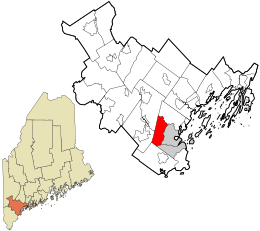Saccarappa, Maine
| Westbrook, Maine | ||
|---|---|---|
| City | ||

Presumpscot River, looking upstream towards One Riverfront Plaza and Saccarappa Falls
|
||
|
||
 Location in Cumberland County and the state of Maine. |
||
| Location in the United States | ||
| Coordinates: 43°41′7″N 70°21′26″W / 43.68528°N 70.35722°WCoordinates: 43°41′7″N 70°21′26″W / 43.68528°N 70.35722°W | ||
| Country | United States | |
| State | Maine | |
| County | Cumberland | |
| Incorporated | 1814 | |
| Government | ||
| • Mayor | Michael Sanphy | |
| Area | ||
| • Total | 17.33 sq mi (44.88 km2) | |
| • Land | 17.12 sq mi (44.34 km2) | |
| • Water | 0.21 sq mi (0.54 km2) | |
| Elevation | 75 ft (23 m) | |
| Population (2010) | ||
| • Total | 17,494 | |
| • Estimate (2012) | 17,606 | |
| • Density | 1,021.8/sq mi (394.5/km2) | |
| Time zone | Eastern (EST) (UTC−5) | |
| • Summer (DST) | EDT (UTC−4) | |
| ZIP codes | 04092, 04098 | |
| Area code | 207 | |
| FIPS code | 23-82105 | |
| GNIS feature ID | 0578237 | |
| Website | www.westbrookmaine.com | |
Westbrook is a city in Cumberland County, Maine, United States and a suburb of Portland. The population was 17,494 at the 2010 census. It is part of the Portland–South Portland–Biddeford, Maine metropolitan statistical area.
Originally known as Saccarappa after Saccarappa Falls on the Presumpscot River, it was a part of Falmouth until February 14, 1814, when it was set off and incorporated as Stroudwater. It soon changed its name to Westbrook after Colonel Thomas Westbrook, a commander during Father Rale's War and King's mast agent who was an early settler and mill operator. In 1871, Saccarappa amicably split into two municipalities; the current Westbrook and Deering, which was then annexed by Portland in 1898. In 1891, Westbrook was incorporated as a city.
Saccarappa Falls and Congin Falls provided water power for early mills within the city. In 1829, a sawmill was built at the former which made the mill town noted for its lumber. Other industries followed, manufacturing grain bags, machinery and water wheels, carriage and harness, boots, shoes and moccasins, tinware, leather board, bricks, wooden boxes, box shook, meal and flour. The Portland Manufacturing Company built a cotton textile mill at Saccarappa Falls for making "sheetings, stripes and ducks." A paper mill was built at Cumberland Mills, once an Indian planting ground known as Ammoncongin. By 1859, it produced 1,000 tons of paper annually. In 1867, the factory's name would change to the S. D. Warren Paper Mill.
...
Wikipedia


